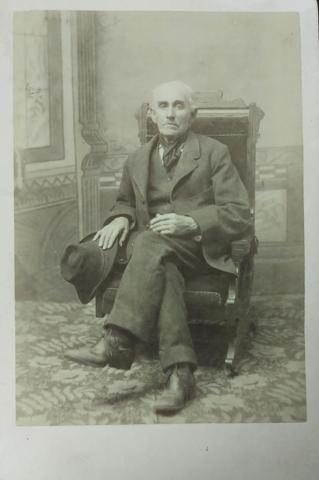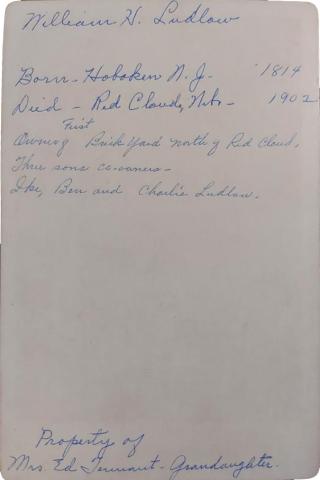

Ludlow Family
William Ludlow (1814–1902) came from Brush Grove, Iowa, to Webster County in 1873. He and his wife Prudence Candace Bailey first lived south of the Republican River, and later relocated to the farm north of Red Cloud described in his recollections below. At first a farmer, he took up brick-making in order to support his large family and the town itself.
During the brick building boom that began in 1883, Ludlow's brick yard was responsible for making more than a million bricks, thanks to the help of a skilled artisan named Atkins. The very next season, William Ludlow turned over the management of the yard to his sons, Charles S. Ludlow and Benjamin P. Ludlow.
Brick Making As an Early Red Cloud Industry
By Vera Ludlow Tennant, granddaughter of the man who started the brick yards
1958
It was some 80 years ago that my grandfather, William Ludlow, a retired minister, purchased our old home north of town where Herb Lambrecht now lives.
Coming from Brush Grove, northeastern Iowa, near where the Amana colonies are now located, he purchased from the government this 80 acres tract of land, ideally located on Crooked Creek.
Having a large household he soon found out that farming could not support such a group so he turned to the making of brick. And why not? He had all the necessary material right at hand and the "know-how" he brought from his Iowa home.
The need was great in this new community for better building supplies, as sod houses were being replaced by frame structures that needed brick for chimneys and foundations. Crooked Creek wandered along the southern border of the farm so there was a never ending supply of water. There was a fine grade of sand in the creek bed, and to the east side of the farm were clay banks 25-30 feet high. All the needed material was near at hand so members of the family proceeded to make brick in a yard near the clay tank at first. The yard was a crude affair and the finished brick was slop brick, not handsome but very durable. Later on a much better brick yard was built nearer the house but still close to the creek.
I am deeply indebted to Ben Pegg, now eighty five years old, for some of this early history, he being the only one now living in the community who worked at one time at this brick yard, and at one time even lived in a dug out with his family on the creek bank. I think he's dead now.
Several other relatives came from Iowa and they too built "make shift" homes along the shady creek banks and worked at the brick yard for a living. Maybe my Grandfather Ludlow had the idea of establishing another Amana colony; I do not know.
There were three operators during the thirty some years of brick making here. My grandfather and one of his sons-in-law Mike Smith, operated the first yard making the so called "slop-brick."
Then along came a man from Michigan, Atkins by name, that really knew how to make good brick, serviceable and good looking too. They were made of the same material, clay, sand and water in a proper mixture, but the last mixing was rolled in fine sand much like one would roll a loaf of bread-dough in sugar. This process gave more body to the brick and a very nice product resulted.
